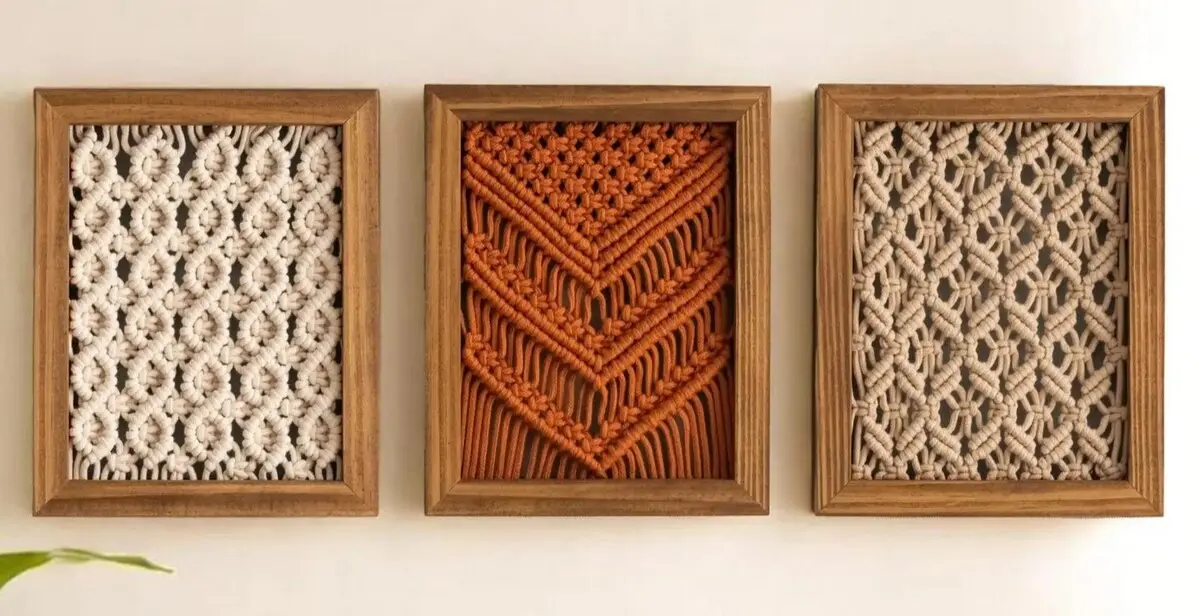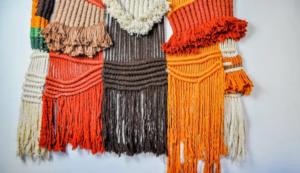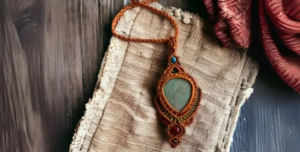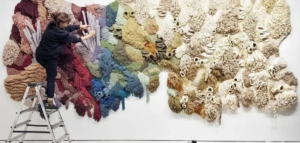The difference between amateur craft projects and professional artwork often lies not in the quality of the knotting itself, but in how the finished piece is presented to the world. Macrame art framing presentation methods have evolved far beyond simple wooden hoops and basic mounting techniques, encompassing sophisticated display solutions that elevate handcrafted pieces to museum-quality presentations that command respect and premium pricing in galleries, exhibitions, and luxury markets.
Modern macrame art framing presentation methods represent a fusion of traditional craftsmanship with contemporary design principles, creating display solutions that enhance rather than compete with the organic beauty of knotted cord work. These professional techniques address common challenges like maintaining proper tension, preventing sagging over time, protecting delicate fibers from environmental damage, and creating stunning visual impact that captivates viewers and establishes the artist’s credibility in competitive markets.
Understanding professional macrame art framing presentation methods becomes crucial for artists seeking to transition from hobby-level crafting to serious artistic practice or commercial success. The investment in proper presentation techniques pays dividends through increased sales prices, gallery acceptance, and professional recognition that opens doors to lucrative commission opportunities and exhibition placements that establish lasting artistic careers.
Foundation Principles of Macrame Art Framing Presentation Methods
The structural integrity of macrame art framing presentation methods begins with understanding weight distribution and tension management across the entire display system. Unlike traditional paintings or photographs, macrame pieces continue to settle and adjust over time, requiring presentation systems that accommodate these natural movements while maintaining visual appeal. Professional framers understand that rigid mounting systems often fail with textile artworks, necessitating flexible approaches that work with rather than against the natural properties of fiber arts.
Visual hierarchy principles guide successful macrame art framing presentation methods by establishing clear relationships between the artwork, mounting system, and surrounding space. The frame or mounting system should enhance the piece without overwhelming its organic character, creating a subtle boundary that defines the artwork’s edges while allowing the eye to focus on the intricate knotwork and textural details that make each piece unique.
Environmental protection considerations in macrame art framing presentation methods address the unique vulnerabilities of textile artworks to dust, moisture, UV radiation, and physical handling. Professional presentation systems incorporate protective elements that preserve the artwork’s condition while maintaining accessibility for viewing and periodic maintenance. Understanding these protection requirements guides material selection and design decisions throughout the framing process.
Traditional Mounting Systems for Macrame Art Framing Presentation Methods
Wooden hoop presentations remain popular in macrame art framing presentation methods due to their organic compatibility with natural fiber aesthetics. Professional-quality hoops feature smooth, snag-free surfaces with consistent grain patterns that complement rather than compete with cord textures. Premium hardwood options like oak, walnut, and cherry develop beautiful patina over time while providing the structural integrity necessary for long-term display stability.
Embroidery hoop adaptations create affordable entry points for macrame art framing presentation methods while offering surprising versatility through size variations and finish options. Professional applications often involve custom-sized hoops, specialized tensioning systems, and decorative treatments that transform basic hoops into sophisticated presentation systems. Understanding hoop selection criteria ensures optimal results for different project scales and aesthetic requirements.
Dowel rod systems provide linear presentation options for macrame art framing presentation methods requiring horizontal emphasis or multiple panel displays. Professional dowel installations incorporate hidden mounting hardware, consistent spacing systems, and coordinated finish treatments that create cohesive presentations. These systems work particularly well for room dividers, window treatments, and architectural installations where traditional framing approaches prove impractical.
Branch and driftwood mountings bring natural authenticity to macrame art framing presentation methods while creating unique, one-of-a-kind presentation systems. Professional preparation techniques ensure structural stability while preserving natural character through appropriate cleaning, treatment, and mounting procedures. Understanding wood species characteristics and preservation requirements guides successful natural mounting implementations.
Contemporary Frame Solutions for Macrame Art Framing Presentation Methods
Shadow box configurations provide dimensional display options for macrame art framing presentation methods requiring depth accommodation and environmental protection. Professional shadow boxes incorporate museum-quality materials, UV-filtering glazing, and climate control features that preserve textile artworks while enabling clear viewing from multiple angles. Custom depth dimensions accommodate varying cord thicknesses and dimensional elements without compromising visual appeal.
Floating mount systems create dramatic visual effects in macrame art framing presentation methods by suspending artwork within frame boundaries without visible support structures. These sophisticated systems use hidden tensioning cables, magnetic mounting points, or specialized hardware that maintains proper artwork positioning while creating the illusion of floating suspension. Professional installation requires precise measurements and specialized tools for optimal results.
Metal frame adaptations bring contemporary aesthetics to macrame art framing presentation methods while providing superior structural strength for large-scale installations. Aluminum, steel, and brass frame systems offer clean lines and modern appeal that complement contemporary interior design while accommodating the unique mounting requirements of textile artworks. Understanding metal frame capabilities guides appropriate selection for different project requirements.
Acrylic and glass mounting systems provide sleek, minimal presentation options for macrame art framing presentation methods emphasizing clean, uncluttered aesthetics. These systems use transparent materials to create boundaries and protection while maintaining maximum visual access to the artwork itself. Professional acrylic systems incorporate UV filtering, anti-reflective coatings, and specialized mounting hardware designed for textile applications.
Innovative Display Technologies for Macrame Art Framing Presentation Methods
LED backlighting systems transform macrame art framing presentation methods into dynamic installations that change appearance throughout the day. Professional LED installations use color-matched lighting, dimming controls, and even illumination patterns that enhance textile textures without creating harmful heat buildup. These systems work particularly well for translucent or semi-transparent cord materials that create interesting shadow and light play effects.
Interactive display systems incorporate sensors and responsive elements into macrame art framing presentation methods that engage viewers through movement, sound, or lighting changes. These cutting-edge presentations appeal to contemporary audiences while creating memorable experiences that distinguish artwork in competitive exhibition environments. Understanding technology integration requirements guides successful interactive implementation.
Rotating display mechanisms enable multiple viewing angles for three-dimensional macrame pieces within compact macrame art framing presentation methods installations. Professional rotating systems use quiet motors, speed controls, and safety features that showcase artwork effectively while ensuring reliable operation in gallery and commercial environments. These systems work particularly well for sculptural pieces and complex multi-sided compositions.
Projection mapping technologies create immersive environments around macrame art framing presentation methods that enhance viewer engagement through coordinated visual effects. These advanced systems project complementary patterns, colors, or animations onto surrounding surfaces while highlighting the physical artwork as the central focus. Understanding projection requirements guides successful multimedia integration.
Conservation and Protection in Macrame Art Framing Presentation Methods
Archival material selection ensures long-term preservation in macrame art framing presentation methods designed for museum or collector applications. Acid-free mounting boards, conservation-grade adhesives, and chemically stable frame materials prevent deterioration reactions that can damage textile artworks over time. Professional conservation standards guide material selection and application procedures for maximum artwork longevity.
Climate control considerations address environmental stability requirements for sensitive macrame art framing presentation methods installations. Professional systems monitor and control humidity, temperature, and air circulation to prevent fiber degradation, mold growth, and dimensional changes that can compromise artwork integrity. Understanding climate requirements guides appropriate environmental control implementation.
UV protection systems filter harmful radiation that can cause color fading and fiber weakening in macrame art framing presentation methods exposed to natural or artificial lighting. Professional UV filtering uses specialized glazing materials, window films, or lighting filters that provide protection while maintaining visual clarity. Understanding UV damage mechanisms guides appropriate protection system selection.
Pest prevention strategies protect textile artworks from insect damage through integrated pest management approaches in macrame art framing presentation methods. Professional prevention systems use physical barriers, environmental controls, and monitoring systems to detect and prevent pest intrusions before damage occurs. Understanding pest vulnerabilities guides comprehensive protection system design.
Professional Installation Techniques for Macrame Art Framing Presentation Methods
Wall mounting systems accommodate varying wall types and structural requirements for macrame art framing presentation methods in residential, commercial, and gallery applications. Professional installations use appropriate anchoring systems, load distribution hardware, and safety factors that ensure secure mounting while preventing wall damage. Understanding structural requirements guides safe installation procedures.
Ceiling suspension systems provide dramatic presentation options for large-scale macrame art framing presentation methods that require overhead mounting or room-spanning installations. Professional suspension systems incorporate aircraft cables, specialized hardware, and engineering calculations that ensure safe operation under all loading conditions. These systems work particularly well for architectural installations and public spaces.
Freestanding display solutions enable flexible positioning for macrame art framing presentation methods in temporary exhibitions, trade shows, or spaces where permanent installation is not feasible. Professional freestanding systems provide stability, portability, and easy setup while maintaining presentation quality comparable to permanent installations. Understanding portability requirements guides appropriate system selection.
Modular mounting systems enable reconfiguration and expansion of macrame art framing presentation methods installations as collections grow or space requirements change. Professional modular systems use standardized components, flexible connections, and scalable designs that accommodate evolving display needs while maintaining consistent presentation quality. These systems provide excellent long-term value for growing collections.
Lighting Design for Macrame Art Framing Presentation Methods
Natural lighting considerations optimize daylight exposure for macrame art framing presentation methods while preventing UV damage and uneven illumination. Professional lighting design addresses window orientation, seasonal variations, and glare control to create optimal viewing conditions throughout the day. Understanding natural lighting characteristics guides appropriate window treatments and positioning decisions.
Artificial lighting systems provide controlled illumination for macrame art framing presentation methods in interior spaces or evening viewing conditions. Professional lighting design uses color-matched sources, even distribution patterns, and adjustable intensity controls that enhance textile textures while preventing heat damage. LED systems offer energy efficiency and heat reduction benefits for sensitive textile applications.
Track lighting configurations provide flexible illumination options for macrame art framing presentation methods in gallery or exhibition settings. Professional track systems use adjustable fixtures, beam angle controls, and coordinated spacing that creates even illumination across multiple artworks while accommodating different sizes and mounting heights. These systems enable easy reconfiguration for changing exhibitions.
Accent lighting techniques create dramatic highlighting effects for specific elements within macrame art framing presentation methods while maintaining overall illumination balance. Professional accent lighting uses focused beams, color temperature variations, and intensity gradients that draw attention to featured areas while maintaining overall composition harmony. Understanding accent lighting principles guides effective implementation.
Custom Solutions and Specialized Applications for Macrame Art Framing Presentation Methods
Architectural integration approaches incorporate macrame art framing presentation methods into building design as permanent installations that enhance interior environments. Professional architectural integration requires coordination with interior designers, architects, and building systems to create seamless installations that appear integral to the space design. Understanding architectural requirements guides successful integration projects.
Outdoor presentation systems address weather resistance and environmental durability requirements for macrame art framing presentation methods in landscape and architectural applications. Professional outdoor systems use weather-resistant materials, drainage systems, and protective treatments that maintain presentation quality while withstanding environmental exposure. Understanding outdoor challenges guides appropriate system design.
Transportation and shipping considerations ensure safe handling for macrame art framing presentation methods between locations or for traveling exhibitions. Professional transportation systems use protective packaging, shock absorption, and handling procedures that prevent damage during transit while maintaining presentation quality upon arrival. Understanding transportation requirements guides packaging design and handling procedures.
Multi-piece installation coordination addresses spacing, alignment, and visual relationships for complex macrame art framing presentation methods involving multiple artworks or panel installations. Professional coordination uses measurement systems, layout templates, and installation sequences that ensure consistent spacing and proper visual flow across entire installations. Understanding multi-piece requirements guides successful complex installations.
Business and Marketing Applications of Macrame Art Framing Presentation Methods
Gallery presentation standards ensure macrame art framing presentation methods meet professional exhibition requirements for commercial gallery representation. Understanding gallery standards guides presentation decisions that enhance artwork marketability while meeting curator expectations for professional quality. Proper presentation often determines gallery acceptance and price positioning opportunities.
Photography and documentation techniques capture macrame art framing presentation methods effectively for portfolio development, marketing materials, and online sales platforms. Professional photography addresses textile texture challenges, lighting requirements, and composition principles that showcase both the artwork and its presentation system effectively. Understanding photography requirements guides documentation planning and execution.
Price positioning strategies leverage professional macrame art framing presentation methods to justify premium pricing and position artwork in luxury market segments. Professional presentation communicates quality and value to potential buyers while differentiating artwork from amateur or craft-market alternatives. Understanding market positioning guides presentation investment decisions and pricing strategies.
Commission project requirements often specify presentation standards for macrame art framing presentation methods in commercial and residential installations. Professional artists must understand client expectations, building requirements, and maintenance considerations when proposing presentation solutions for commissioned work. Meeting professional presentation standards ensures client satisfaction and referral opportunities.
Maintenance and Care Protocols for Macrame Art Framing Presentation Methods
Regular inspection schedules ensure early detection of potential problems in macrame art framing presentation methods before they compromise artwork integrity. Professional maintenance protocols include systematic inspection procedures, documentation systems, and preventive care measures that extend presentation system lifespan while maintaining artwork condition. Understanding maintenance requirements guides long-term care planning.
Cleaning procedures address both the artwork and presentation system components in macrame art framing presentation methods without causing damage or deterioration. Professional cleaning uses appropriate tools, techniques, and cleaning agents that remove accumulated dust and debris while preserving material integrity. Understanding cleaning requirements guides maintenance procedure development.
Repair and restoration techniques address common problems in aging macrame art framing presentation methods while maintaining historical and artistic integrity. Professional repair approaches use appropriate materials, reversible techniques, and documentation procedures that preserve artwork value while extending useful life. Understanding repair principles guides appropriate restoration decisions.
Upgrade and modernization strategies enable improvement of existing macrame art framing presentation methods as new technologies and techniques become available. Professional upgrade approaches evaluate cost-benefit relationships, compatibility requirements, and artwork safety considerations when implementing improvements. Understanding upgrade options guides evolutionary improvement planning.
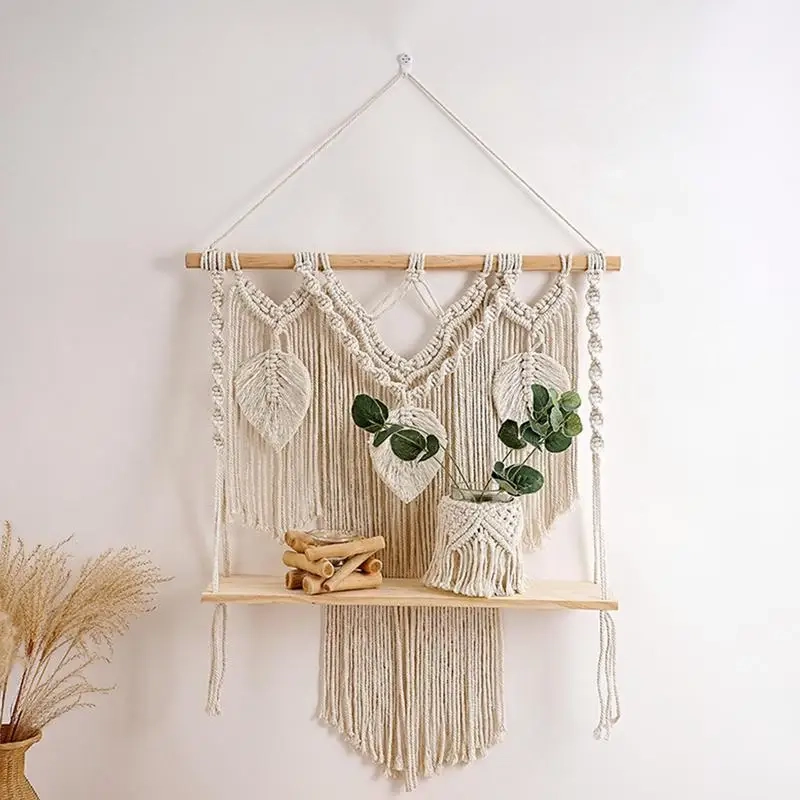
Bohemian Large Macrame Wall Hanging Shelves Boho Decorative
Large Macrame Wall Hanging, where impeccable quality meets sophisticated charm. Expertly handcrafted from high-quality, durable cotton and a sturdy beech wood support, this piece embodies the essence of a minimalist aesthetic—a result of countless hours of precise polishing and intricate craftsmanship.
Frequently Asked Questions
What are the most important factors to consider when selecting professional macrame art framing presentation methods for gallery exhibition?
Gallery presentations require meeting professional standards for structural integrity, conservation quality, and visual impact that distinguish serious artwork from craft projects. Focus on archival materials, proper UV protection, and presentation systems that complement rather than compete with your artwork’s organic character. Consider the viewing distance, lighting conditions, and space context where your piece will be displayed. Professional presentation often determines gallery acceptance and influences pricing opportunities, so invest in quality materials and installation techniques that demonstrate your commitment to professional artistic practice.
How do I balance protection and accessibility in macrame art framing presentation methods for pieces that may require periodic maintenance?
Design presentation systems with accessibility features that allow safe artwork removal for cleaning or repair without damaging the mounting system or requiring complete reinstallation. Use reversible attachment methods, modular components, and clear documentation of installation procedures to facilitate future maintenance. Consider the expertise level of those who will perform maintenance and provide appropriate instructions or training. Balance protection needs with practical access requirements based on the artwork’s location, handling frequency, and maintenance complexity.
What cost-effective approaches work best for emerging artists developing professional macrame art framing presentation methods?
Start with high-quality basic systems that can be upgraded over time rather than attempting comprehensive professional presentations beyond your current budget. Invest in good foundation elements like proper mounting hardware and UV-filtering glazing while using simpler frame materials that can be enhanced later. Focus on clean, consistent presentation standards rather than expensive materials, and consider modular systems that allow incremental improvements. Document successful approaches and gradually build a collection of quality presentation components that can be reused across multiple projects.
How do environmental factors influence macrame art framing presentation methods selection for different installation locations?
Environmental conditions dramatically impact material selection and protection requirements for macrame presentation systems. High humidity locations require moisture barriers and ventilation systems, while dry environments may need humidification considerations. UV exposure levels determine glazing requirements, and temperature fluctuations affect material expansion and mounting system design. Consider air quality, handling frequency, and security requirements when selecting presentation approaches. Conduct site assessments and choose materials and techniques specifically matched to the environmental challenges of each installation location.
Conclusion
Professional macrame art framing presentation methods represent the crucial bridge between skilled craftsmanship and serious artistic recognition. The investment in quality presentation techniques transforms handcrafted pieces into gallery-worthy artworks that command respect, premium pricing, and professional opportunities that elevate artistic careers. Understanding the diverse options available—from traditional mounting systems to cutting-edge interactive displays—empowers artists to select presentation approaches that enhance their unique artistic vision while meeting professional standards.
Success in macrame art framing presentation methods requires balancing aesthetic appeal with practical considerations like conservation, accessibility, and environmental protection. By starting with solid foundational techniques and gradually incorporating advanced presentation technologies, artists can develop presentation capabilities that grow with their artistic development and market positioning. The commitment to professional presentation standards demonstrates artistic seriousness while creating lasting value that protects both the artwork and the artist’s investment in their creative development.

